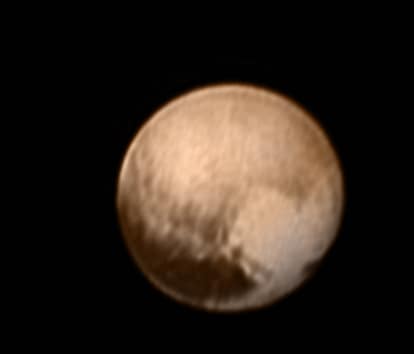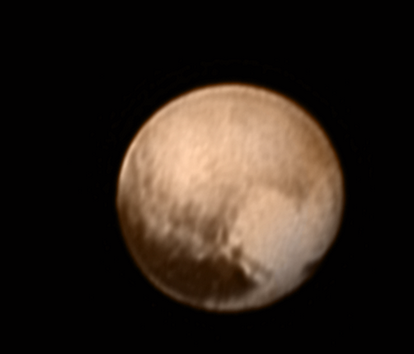Cape Canaveral: Pluto, reveal thyself, and Earthlings, enjoy the show. On Tuesday, NASA’s New Horizons spacecraft will sweep past Pluto and present the previously unexplored world in all its icy glory. It promises to be the biggest planetary unveiling in a quarter-century. The curtain hasn’t been pulled back like this since NASA’s Voyager 2 shed light on Neptune in 1989. Now it’s little Pluto’s turn to shine way out on the frigid fringes of our solar system. New Horizons has traveled 3 billion miles over 9½ years to get to this historic point. The fastest spacecraft ever launched, it carries the most powerful suite of science instruments ever sent on a scouting and reconnaissance mission of a new, unfamiliar world. Guarantees principal scientist Alan Stern, “We’re going to knock your socks off.” The size of a baby grand piano, the spacecraft will come closest to Pluto on Tuesday morning — at 7:49 a.m. EDT. That’s when New Horizons is predicted to pass within 7,767 miles of Pluto. Fourteen minutes later, the spacecraft will zoom within 17,931 miles of Charon, Pluto’s jumbo moon. For the plutophiles among us, it will be cause to celebrate, especially for those gathered at the operations center at Johns Hopkins University’s Applied Physics Laboratory in Laurel, Maryland. The lab designed and built the spacecraft for NASA, and has been managing its roundabout route through the solar system. [caption id=“attachment_2334152” align=“alignleft” width=“414”]  Courtsey Twitter @Alex_Parker[/caption] “What NASA’s doing with New Horizons is unprecedented in our time and probably something close to the last train to Clarksville, the last picture show, for a very, very long time,” says Stern, a planetary scientist with the Southwest Research Institute in Boulder, Colorado. It is the last stop in NASA’s quest to explore every planet in our solar system, starting with Venus in 1962. And in a cosmic coincidence, the Pluto visit falls on the 50th anniversary of the first-ever flyby of Mars, by Mariner 4. Yes, we all know Pluto is no longer an official planet, merely a dwarf, but it still enjoyed full planet status when New Horizons rocketed from Cape Canaveral, Florida, on 19 January, 2006. Pluto’s demotion came just seven months later, a sore subject still for many. “We’re kind of running the anchor leg with Pluto to finish the relay,” Stern says. The sneak peeks of Pluto in recent weeks are getting “juicier and juicier,” says Johns Hopkins project scientist Hal Weaver. “The science team is just drooling over these pictures.” The Hubble Space Telescope previously captured the best pictures of Pluto. If the pixelated blobs of pictures had been of Earth, though, not even the continents would have been visible. The New Horizons team is turning “a point of light into a planet,” Stern says. An image released last week shows a copper-colored Pluto bearing, a large, bright spot in the shape of a heart. Scientists expect image resolution to improve dramatically by Tuesday. The 7,767-mile span at closest approach is about the distance between Seattle and Sydney. New Horizons, weighing less than 1,000 pounds including fuel, has seven instruments that will be going full force during the encounter. It’s expected to collect 5,000 times as much data, for instance, as Mariner 4. “We’re going to rewrite the book,” Weaver says. “This is it — this is our once-in-a-lifetime opportunity to see it.” The team gets one crack at this. “We’re trying to hit a very small box, relatively speaking,” says Mark Holdridge, the encounter mission manager. “It’s 60 by 90 miles, and we’re going 30,000 mph, and we’re trying to hit that box within a plus or minus 100 seconds.” The only planet in our solar system discovered by an American, Pluto actually is a mini solar system unto itself. Pluto — just two-thirds the size of our own moon — has big moon Charon that’s just over half its size, as well as baby moons Styx, Nix, Hydra and Kerberos. The names are associated with the underworld in which the mythological god, Pluto, reigned. New Horizons will observe each known moon and keep a lookout for more. Scientists involved in the $700 million effort want to get a good look at Pluto and Charon, and get a handle on their surfaces and chemical composition. They also plan to measure the temperature and pressure in Pluto’s nitrogen-rich atmosphere and determine how much gas is escaping into space. Temperatures can plunge to nearly minus-400 degrees. Bill McKinnon, a New Horizons team member from Washington University in St. Louis, Missouri, expects to see craters and possible volcanic remnants. A liquid ocean and a rocky core may lie beneath the icy shell. “Anybody who thinks that when we go to Pluto, we’re going to find cold, dead ice balls is in for a rude shock,” McKinnon says. “I’m really hoping to see a very active and dynamic world.” Pluto has tantalized astronomers since its 1930 discovery by Clyde Tombaugh using the Lowell Observatory in Flagstaff, Arizona. Some of Tombaugh’s ashes are aboard New Horizons. His two children, now in their 70s, plan to be at Johns Hopkins for the encounter. With its tilted, elongated 248-year orbit, Pluto has made it only a third of the way around the sun since its discovery. The amount of sunlight that reaches Pluto is so dim that at high noon it looks like twilight here on Earth. The massive surrounding Kuiper Belt, in fact, is called the Twilight Zone. The New Horizons team has its eyes on a few much smaller objects in the Kuiper Belt, and is hoping for a mission extension as the spacecraft continues toward the solar system exit on the heels of NASA’s Voyagers 1 and 2 and Pioneers 10 and 11. For now, signals take 4½ hours to travel one-way between New Horizons and flight controllers in Maryland. New Horizons’ science instruments will be cranked up to collect maximum data Tuesday, leaving no time to send back data. In fact, scientists won’t be absolutely certain of success until Tuesday night, 13 hours following New Horizons’ closest approach, when it “phones home.” It will be Wednesday before the closest of Pluto’s close-ups are available for release. And it will be well into next year — October 2016 — before all the anticipated data are transmitted to Earth. “We’re all going to have to be patient,” urges deputy project scientist Cathy Olkin. For everyone involved, this is a mission of delayed gratification. AP
Pluto, reveal thyself, and Earthlings, enjoy the show.
Advertisement
End of Article
Written by FP Archives
see more


)
)
)
)
)
)
)
)
)



